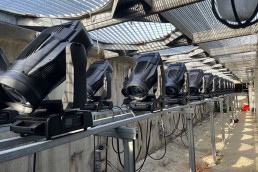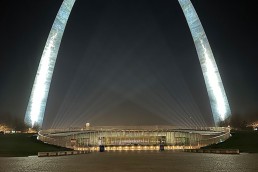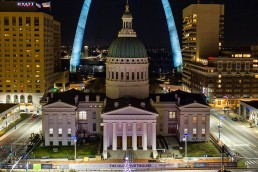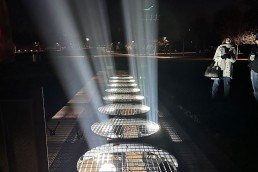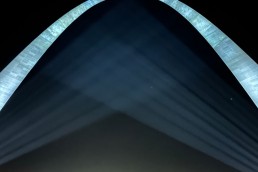This website uses cookies so that we can provide you with the best user experience possible. Cookie information is stored in your browser and performs functions such as recognising you when you return to our website and helping our team to understand which sections of the website you find most interesting and useful.
St. Louis Gateway Arch
ProjectSt. Louis Gateway ArchLocationMissouri, USAArchitectEero SaarinenLighting DesignerTechnical Productions, Inc; Randy Burkett of Reed Burkett Lighting DesignInstallerTechnical Productions, Inc., USASubmitted byElation Professional
One of America’s most iconic monuments, the Gateway Arch in St. Louis, shines more brightly than ever thanks to a new lighting system from Technical Productions, Inc. TPI proposed a lighting upgrade after years maintaining outdated xenon lamp lighting, a system that was not only proving unreliable and expensive to upkeep but wasn’t showing the Arch in its best light. The solution lay in Elation’s Proteus Brutus, an IP65-rated automated light with a high efficiency 1200W peak field LED engine and 75,000 total lumens of output.
The Gateway Arch is a complex shape—a weighted catenary arch 16.5 m wide at its base narrowing to 5.2 m at the top. Clad in stainless steel and 192 m tall, it is the world’s tallest arch. To light the structure, 76 Proteus Brutus fixtures were placed in four existing lighting pits at the legs of the Arch. The pits were modified by TPI to house the 104-pound Brutus fixtures (previous fixture weight was 450 pounds!) with strut rails added that run the length of the pit to allow the fixtures to move when needed for focusing.
The Brutus fixtures that shoot to the top of the Arch are zoomed at 4 degrees with the zoom angle widening as you work your way down the Arch. At the base, the angle widens to approximately 22 degrees. The Proteus Brutus’s intelligent controllability gave several other advantages over the previous 7K xenon fixtures such as the ability to dim, focus and color correct more precisely. Also, pinpoint focus accuracy and indexable beam-shaping gobos means there is much less overshoot. This makes the Arch appear brighter while reducing flare in the night skies, an important element for protecting migratory birds who frequently pass through the Mississippi Flyway.
The new lighting system has also resulted in substantial power savings, with the LED fixtures consuming only 1200 watts per unit compared to the previous arc source units at 7000 watts per unit. This 60% reduction in power consumption, coupled with the elimination of frequent lamp changes, contributes to significant savings in both energy and costs.
Nick Vincenty, Director of System Design and Engineering at Technical Productions, was heavily involved in the project and touched on the challenge involved. “We needed to shoot 650 feet straight up at a target 25 ft wide, which isn’t an easy thing to do. This [Proteus Brutus] was the first fixture we saw that not only had the output to do it but the zoom optics to do it accurately, plus it’s IP65. It’s really the only LED fixture that met the requirement.”
The Gateway Arch is a complex shape—a weighted catenary arch 54 feet (16.5 m) wide at its base narrowing to 17 feet (5.2 m) at the top. Clad in stainless steel and 630-ft tall (192 m), it is the world’s tallest arch. To light the structure, 76 Proteus Brutus fixtures were placed in four existing lighting pits at the legs of the Arch.
Vincenty explains that the Brutus fixtures that shoot to the top of the Arch are zoomed at 4 degrees with the zoom angle widening as you work your way down the Arch. At the base, the angle widens to approximately 22 degrees (the Brutus can zoom out to 45 degrees). “The previous 7K xenon fixtures could only zoom with special filters which wasn’t very effective and we ended up losing over half of the lumens into space,” he said.
With the previous system, prismatic film used to elongate the beams had to be changed often because it degraded quickly. The Brutus houses several indexable beam-shaping gobos like rectangles and squares that are used to provide more precise focus onto the Arch and thus avoid light spill.
Vincenty says that although the Arch is not an easy object to light—“it’s basically like trying to light a mirror”—the difference between the old and new lighting is substantial.
Moreover, the Proteus Brutus incorporates a ‘sun protection’ feature, ensuring the longevity of the fixtures by pointing the lens towards the ground in the event of control signal loss, protecting the lens and components inside the fixture against sun damage.
The Gateway Arch in St. Louis is one of America’s most iconic monuments. It has stood on the banks of the Mississippi River in St. Louis since 1965 as America’s symbolic “Gateway to the West.” Clad in stainless steel and 192 m, it is the world’s tallest arch.
The outdated xenon lamp system used to light it was not only proving unreliable and expensive to upkeep but wasn’t showing the Arch in its best light. “Parts were breaking and the cost in lens filters and lamps, not to mention the labor to change them, was very high,” Michael O’Keefe of TPI stated. “I truly felt that we should honor our monument more consistently and more efficiently with the best available fixtures.”
The fact that the Brutus can easily zoom to put all of the lumens on the Arch plus its intelligent controllability – the ability to dim, focus, color correct more precisely, and its pinpoint accuracy – means the Arch is brighter with less flare and an overall higher quality of light.
The difference between the old and new lighting is substantial. “It’s really like night and day. The more lighting we’re putting on the Arch, and the higher 6,500 kelvin we’re lighting it at with the Brutus, looks a lot better. Being able to have a lot more control over where we put the light and what quality of light we put there makes a big difference,” states Nick Vincenty, Director of System Design and Engineering at Technical Productions.
The Proteus has made it a better system, especially with regards to beam discipline. The Gateway Foundation are very good stewards in wanting to minimize the impact of lighting on anything other than the Arch itself and this luminaire has allowed that to happen.
The new lighting system has also resulted in substantial power savings, with the LED fixtures consuming only 1200 watts per unit compared to the previous arc source units at 7000 watts per unit. This 60% reduction in power consumption, coupled with the elimination of frequent lamp changes, contributes to significant savings in both energy and costs.
